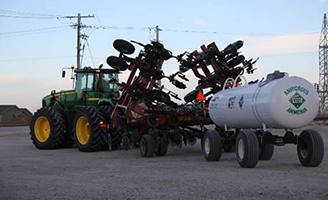 Once you’ve completed anhydrous ammonia applications for the spring season, the work isn’t over. You’ll want to ensure you’re storing anhydrous safely while it waits until the next application. It’s a hazardous chemical that must be dealt with very carefully.
Once you’ve completed anhydrous ammonia applications for the spring season, the work isn’t over. You’ll want to ensure you’re storing anhydrous safely while it waits until the next application. It’s a hazardous chemical that must be dealt with very carefully.
Here are some tips to keep in mind when storing anhydrous ammonia/N-Serve® nitrogen stabilizer:
- Ensure all facilities, equipment and installations meet with federal, state and local codes and regulations.
- Use stainless steel totes, avoiding moisture.
- N-Serve® nitrogen stabilizer must be stored in a closed handling system to prevent spillage to items that may not be compatible.
- A storage temperature of 18 degrees Fahrenheit or higher must be maintained to avoid crystallization.
- Pumping units must be flushed with kerosene at the end of the season
- Always follow specifications for tanks and trailers.
- Inspect tanks and trailers, looking for dents, thinning, corrosion, paint issues, placard issues, loose anchor bolts, etc.
- Change relief valves within five years of the date of manufacture.
- Fully empty everything and drop the pressure to zero when making repairs.
Here are some tips to remember when transporting anhydrous/N-Serve:
- Follow state-specific regulations, which you can find at your local department of agriculture.
- Travel at or below 25 miles per hour.
- Add a slow-moving vehicle (SMV) emblem to the towing assembly to alert other drivers.
- Check state regulations regarding the number and status (full or empty) of tanks you can pull.
- Always use a hitch pin with a safety keeper/retainer clip and two independent safety chains when towing.
- N-Serve tanks with a capacity of 120 gallons or more require placards.
The tips listed above are some, but not all of the many safety measures you’ll want to take when dealing with anhydrous ammonia. If you experience an accident with anhydrous ammonia, you’ll want to report that to the National Response Center right away at 1.800.424.8802.
To learn how N-Serve® works to protect anhydrous ammonia applications, visit NitrogenMaximizers.com.
™ ® Instinct is not registered for sale or use in all states. Contact your state pesticide regulatory agency to determine if a product is registered for sale or use in your state. Do not fall-apply anhydrous ammonia south of Highway 16 in the state of Illinois. Always read and follow label directions.
 Once you’ve completed anhydrous ammonia applications for the spring season, the work isn’t over. You’ll want to ensure you’re storing anhydrous safely while it waits until the next application. It’s a hazardous chemical that must be dealt with very carefully.
Once you’ve completed anhydrous ammonia applications for the spring season, the work isn’t over. You’ll want to ensure you’re storing anhydrous safely while it waits until the next application. It’s a hazardous chemical that must be dealt with very carefully.